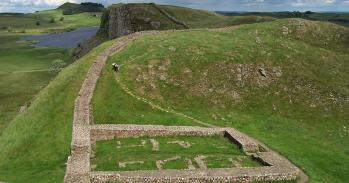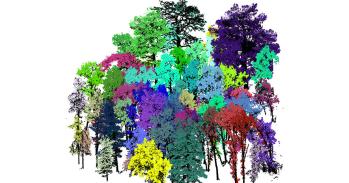
By observing the night sky, medieval monks unwittingly recorded some of history’s largest volcanic eruptions, according to a new analysis of 12th and 13th century European and Middle Eastern chronicles.
By observing the night sky, medieval monks unwittingly recorded some of history’s largest volcanic eruptions, according to a new analysis of 12th and 13th century European and Middle Eastern chronicles.
An international team, including researchers from the University of Cambridge, drew on readings of medieval texts, along with ice core and tree ring data, to accurately date some of the biggest volcanic eruptions the world has ever seen. Their results, reported in the journal Nature, uncover new information about one of the most volcanically active periods in Earth’s history, which some think helped to trigger the Little Ice Age, a long interval of cooling that saw the advance of European glaciers.
It took the researchers, led by the University of Geneva (UNIGE), almost five years to examine hundreds of annals and chronicles from across Europe and the Middle East, in search of references to total lunar eclipses and their colouration.
Total lunar eclipses occur when the moon passes into the Earth’s shadow. Typically, the moon remains visible as a reddish orb because it is still bathed in sunlight bent round the Earth by its atmosphere. But after a very large volcanic eruption, there can be so much dust in the stratosphere – the middle part of the atmosphere starting roughly where commercial aircraft fly – that the eclipsed moon almost disappears.
Medieval chroniclers recorded and described all kinds of historical events, including the deeds of kings and popes, important battles, and natural disasters and famines. Just as noteworthy were the celestial phenomena that, to the chroniclers, might foretell such calamities. Mindful of the Book of Revelation, a vision of the end times that speaks of a blood-red moon, the monks were especially careful to take note of the moon’s colouration.
Of the 64 total lunar eclipses that occurred in Europe between 1100 and 1300, the chroniclers had faithfully documented 51. In five of these cases, they also reported that the moon was exceptionally dark.
Asked what made him connect the monks’ records of the brightness and colour of the eclipsed moon with volcanic gloom, the lead author of the work, UNIGE’s Sébastien Guillet said: “I was listening to Pink Floyd's Dark Side of the Moon album when I realised that the darkest lunar eclipses all occurred within a year or so of major volcanic eruptions. Since we know the exact days of the eclipses, it opened the possibility of using the sightings to narrow down when the eruptions must have happened.”
The researchers found that scribes in Japan took equal note of lunar eclipses. One of the best known, Fujiwara no Teika, wrote of an unprecedented dark eclipse observed on 2 December 1229: ‘the old folk had never seen it like this time, with the location of the disk of the Moon not visible, just as if it had disappeared during the eclipse... It was truly something to fear.’
The stratospheric dust from large volcanic eruptions was not only responsible for the vanishing moon. It also cooled summer temperatures by limiting the sunlight reaching the Earth’s surface. This in turn could bring ruin to agricultural crops.
“We know from previous work that strong tropical eruptions can induce global cooling on the order of roughly 1°C over a few years,” said Markus Stoffel from the University of Geneva, a specialist in converting measurements of tree rings into climate data, who co-designed the study. “They can also lead to rainfall anomalies with droughts in one place and floods in another.”
Despite these effects, people at the time could not have imagined that the poor harvests or the unusual lunar eclipses had anything to do with volcanoes – the eruptions themselves were all but one undocumented.
“We only knew about these eruptions because they left traces in the ice of Antarctica and Greenland,” said co-author Professor Clive Oppenheimer from Cambridge’s Department of Geography. “By putting together the information from ice cores and the descriptions from medieval texts we can now make better estimates of when and where some of the biggest eruptions of this period occurred.”
To make the most of this integration, Guillet worked with climate modellers to compute the most likely timing of the eruptions. “Knowing the season when the volcanoes erupted is essential, as it influences the spread of the volcanic dust and the cooling and other climate anomalies associated with these eruptions,” he said.
As well as helping to narrow down the timing and intensity of these events, what makes the findings significant is that the interval from 1100 to 1300 is known from ice core evidence to be one of the most volcanically active periods in history. Of the 15 eruptions considered in the new study, one in the mid-13th century rivals the famous 1815 eruption of Tambora that brought on ‘the year without a summer’ of 1816. The collective effect of the medieval eruptions on Earth’s climate may have led to the Little Ice Age, when winter ice fairs were held on the frozen rivers of Europe.
“Improving our knowledge of these otherwise mysterious eruptions, is crucial to understanding whether and how past volcanism affected not only climate but also society during the Middle Ages,” said Guillet.
The research was supported in part by the Swiss National Science Foundation.
Reference:
Sébastien Guillet et al. ‘Lunar eclipses illuminate timing and climate impact of medieval volcanism.’ Nature (2023). DOI: 10.1038/s41586-023-05751-z

The text in this work is licensed under a Creative Commons Attribution-NonCommercial-ShareAlike 4.0 International License. Images, including our videos, are Copyright ©University of Cambridge and licensors/contributors as identified. All rights reserved. We make our image and video content available in a number of ways – as here, on our main website under its Terms and conditions, and on a range of channels including social media that permit your use and sharing of our content under their respective Terms.




